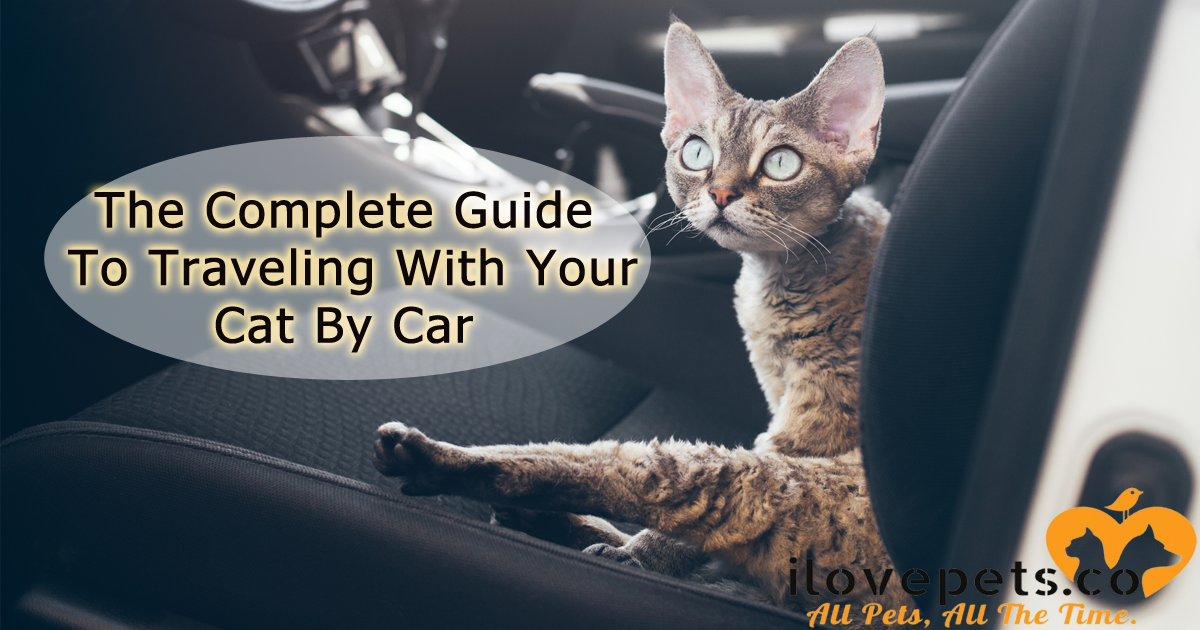
Does your cat hate going into her carrier? Does she scream so loud, your neighbors think you’re killing her every time you try to take her to the vet?
Unlike dogs, cats are not naturally excited about car rides. It’s not unusual for your cat to protest being put in a carrier and traveling in an enclosed space.
But you can teach your cat to calm down during car rides, and even enjoy the peaceful trip… as though it were their idea!
Cats Should ALWAYS Ride In A Carrier
You should never drive with your cat loose in the car.
Cats can be distracting to the driver. They can get underfoot and get in the way of the brake and gas pedal.
In just a few states, it’s illegal to drive with an unrestrained dog, and though these laws do not apply to cats, you could get a ticket for distracted driving if your cat seems to be putting you or others on the road in danger.
While your cat may purr happily in your lap while you drive, if the airbag is deployed, even in a minor collision, it almost certainly will kill your cat.
Cats are safer – and calmer – when they’re not wandering about your vehicle, shifting around every time you brake or turn.
What’s The Best Cat Carrier For Driving?
Only a select few cat carriers pass crash tests by the Center For Pet Safety.
Crash-tested carriers are more expensive, but they’re worth every penny. They are expertly designed and tested to make sure that your cat stays in the carrier, on the seat, in the event of a car crash.
In any other carrier, it is possible for the carrier to launch off the seat, open up, flip over, or otherwise put your cat in harm’s way.
These carriers are built to last, and they can save your cat’s life – so they’re absolutely worth the investment.
These include ALL Sleepypod brand pet travel carriers.
For cats up to 18 pounds, use the Sleepypod Air. Also approved for air travel with most airlines.

For cats up to 12 pounds, use the Sleepypod Atom. Also approved for air travel with most airlines.

For cats up to 7 pounds, use the Sleepypod Mini. Also approved for air travel with most airlines.

For cats up to 15 pounds, use the Sleepypod Mobile Pet Bed.

For cats up to 20 pounds, use the Gen7Pets – Gen7Commuter Carrier. Also approved for air travel with most airlines.

When Your Cat Hates Their Carrier
Cats love enclosed spaces…
As long as it is their idea to hop inside.
Your cat’s carrier should be as comfy to them as their favorite bed or napping nook in your home.
If you’re planning a trip, make sure to get your carrier at least a few weeks in advance. Leave the carrier out at all times so you cat can explore it and their leisure.
You can use treats and catnip to make it even more enticing.
Avoid placing your cat inside unless it’s absolutely necessary. Remember, your cat will love the carrier if they think it was their idea to hop in.
Place the open carrier in your cat’s favorite napping spots. This could be by a window, up on a table, or anywhere they like to lounge. It should be away from areas of heavy foot traffic – a nice refuge where they can relax and snooze.
The round Sleepypod carriers are designed with removable tops and plush bottoms, so they are essentially a cat bed when you are not on the go.
You do not need to leave the carrier out and accessible at all times. You may decide to leave it out until your cat loves it, and then only take it out when it’s time to travel. That way, your cat will rush over and hop in right before you’re ready to leave.
Keeping Your Cat Calm During Car Rides
Even if your cat loves their carrier, they might start to protest when your car starts moving. You can make the carrier a calming place even when you’re driving using a few special tricks.
First, use a calming spray like Feliway to soothe your cat’s nerves. Avoid using essential oil blends made for dogs or people – cats are particularly sensitive to essential oils.
You can also use treats that contain catnip to help your cat relax. Catnip is a stimulant when your cat sniffs it and rolls around in it, but when it is consumed, it is actually a relaxant. You can buy catnip treats, make your own, or sprinkle some onto their canned food.
If your cat experiences extreme anxiety, but you have no choice but to travel, your vet can prescribe a mild sedative to help them relax. Never try dosing over-the-counter medicines or anything made for humans or other pets. Only use medications under your vet’s supervision.
Unlike dogs, who experience calming effects with certain genres of made-for-humans music, cats only respond to music that has been composed especially for them.
Music For Cats features purring, high-pitched tunes and bird songs that appeal to kitty ears. The soundtracks are pleasant enough for you to enjoy, too, while you drive.
It can also help if your cat can see you or another passenger in the car. You can try to position the carrier so that your cat can see you, though it is more important that the carrier is safely buckled in.
Your cat should always ride in the back, not the front seat, as the airbag can injure your cat even with a crash-tested carrier.
Road Trips With Your Cat
If you’re moving or traveling on vacation, your cat can happily snooze in their carrier for hours, if you prepare them ahead of time.
At first, let your cat hang out in your car while you’re parked in the driveway for just a few minutes at a time. Then try short, local trips. Work your way up to a 10 minute, 30 minute, 1 hour, and then 2 hour drive. You may find that your cat handles longer trips more easily as they have plenty of time to acclimate to being in the carrier, rather than being rustled around.
Make sure to keep your cat hydrated. They may not want to drink water during the trip, so you might want to offer soft, canned food during pit stops. It’s not unusual for cats to refuse food and water when they are just getting accustomed to traveling. Take extra care if you are traveling during the hot summer months.
For potty breaks, you can use a disposable litter pan.

Hotel And Motel Stays With Your Cat
Always let the place you are staying at know that you will be traveling with a cat. Most have pet-free rooms for people with severe allergies, so you could be creating a hazard if you do not disclose that you have an animal. If you hide your cat and they find out, they may kick you out.
Many hotels and motels do not have a pet fee, though some do. Aloft Hotels, Kimpton Hotels, Motel 6 and Red Roof Inn always let pets stay free of charge. Other hotels and motels do not allow pets, and the ones that do may charge a nonrefundable per-stay pet deposit of $25-$100.
Another option is an AirBnb. Not all allow pets, and some AirBnbs have pets of their own that your cat may or may not get along with – these details are usually included in each listing, and you can contact the host before making a reservation. AirBnbs do not have pet fees, and many are more lenient and comfortable for cats than hotel chains.
Avoid causing damage to your temporary accommodation. A familiar blanket will help keep your cat calm in the room, and can also help protect furniture that does not belong to you.
You can also bring a small scratch pad to keep your cat from scratching forbidden surfaces without bringing your entire cat tree.
Don’t Lose Your Cat On Car Trips!
On both short and long trips, keep your cat in their carrier until it is safe for them to be released. Even an indoor-outdoor cat who reliably comes home after an adventure can get lost in an unfamiliar terrain.
If your cat likes to explore outdoors, use a leash and harness to keep them from getting lost. This will require preparation, too, as many cats are unable to function the first time they wear a leash.
Before a big trip, make sure your cat is up-to-date on vaccinations and has a microchip. Even if your cat is normally safe indoors, just a few hours of being lost on your trip can result in so much trouble – contracting illnesses from other cats, getting into fights, or getting picked up by someone else.

Traveling With Your Cat Should Be Fun!
If you’re prepared, your cat might surprise you – they really do not need a whole lot to feel cozy enough to just relax wherever the tide takes them.
For some cats, travel will always be stressful. This is especially for adult cats that did not travel as kittens. You may want to hire a pet sitter to visit your cat 1-2 times per day, that way they can stay at home with familiar surroundings.






